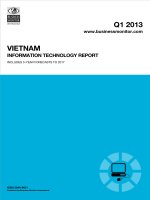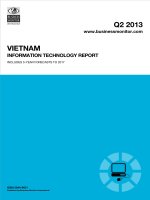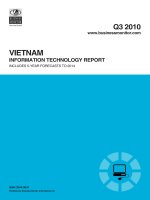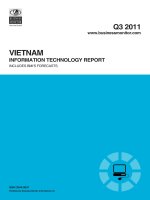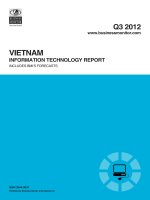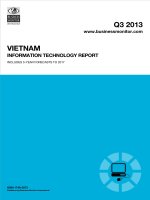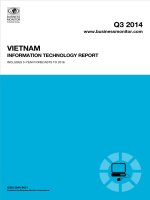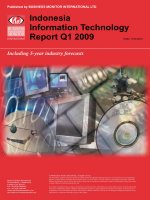Indonesia information technology report q3 2013
Bạn đang xem bản rút gọn của tài liệu. Xem và tải ngay bản đầy đủ của tài liệu tại đây (479.21 KB, 95 trang )
Q3 2013
www.businessmonitor.com
INDONESIA
INFORMATION TECHNOLOGY REPORT
INCLUDES 5-YEAR FORECASTS TO 2017
ISSN 1750-5070
Published by:Business Monitor International
Indonesia Information Technology
Report Q3 2013
INCLUDES 5-YEAR FORECASTS TO 2017
Part of BMI’s Industry Report & Forecasts Series
Published by: Business Monitor International
Copy deadline: May 2013
Business Monitor International
Senator House
85 Queen Victoria Street
London
EC4V 4AB
United Kingdom
Tel: +44 (0) 20 7248 0468
Fax: +44 (0) 20 7248 0467
Email:
Web:
© 2013 Business Monitor International
All rights reserved.
All information contained in this publication is
copyrighted in the name of Business Monitor
International, and as such no part of this
publication may be reproduced, repackaged,
redistributed, resold in whole or in any part, or used
in any form or by any means graphic, electronic or
mechanical, including photocopying, recording,
taping, or by information storage or retrieval, or by
any other means, without the express written consent
of the publisher.
DISCLAIMER
All information contained in this publication has been researched and compiled from sources believed to be accurate and reliable at the time of
publishing. However, in view of the natural scope for human and/or mechanical error, either at source or during production, Business Monitor
International accepts no liability whatsoever for any loss or damage resulting from errors, inaccuracies or omissions affecting any part of the
publication. All information is provided without warranty, and Business Monitor International makes no representation of warranty of any kind as
to the accuracy or completeness of any information hereto contained.
CONTENTS
BMI Industry View 7
SWOT 9
IT 9
Wireline 11
Political 13
Economic 15
Business Environment 17
Industry Forecast 18
Table: Indonesia IT Industry - Historical Data And Forecasts (IDRmn) 18
Broadband 22
Table: Internet - Historical Data And Forecasts, 2010-2017 22
Macroeconomic Forecasts 24
Macroeconomic Forecast 24
Industry Risk Reward Ratings 33
Industry Risk/Reward Ratings 33
Table: Asia Pacific IT Risk/Reward Ratings - Q3 2013 36
Market Overview 37
Hardware 37
Software 44
IT Services 47
Industry Trends And Developments 51
Regulatory Development 55
Table: Key Ministers And Departments 55
Company Profile 59
Hewlett-Packard 59
Oracle Corp 66
Table: Oracle: Selected Acquisitions 67
IBM 73
Table: IBM Acquisitions, 2012 (Total Value, US$3.964bn) 75
Sigma 79
Regional Overview 82
Demographic Forecast 87
Demographic Outlook 87
Indonesia Information Technology Report Q3 2013
© Business Monitor International Page 4
Table: Indonesia's Population By Age Group, 1990-2020 ('000) 88
Table: Indonesia's Population By Age Group, 1990-2020 (% of total) 89
Table: Indonesia's Key Population Ratios, 1990-2020 90
Table: Indonesia's Rural And Urban Population, 1990-2020 90
Methodology 91
Methodology 91
IT Industry 91
IT Ratings - Methodology 92
Table: IT Business Environment Indicators 93
Weighting 94
Table: Weighting Of Components 94
Sources 94
Indonesia Information Technology Report Q3 2013
© Business Monitor International Page 5
BMI Industry View
BMI View: The Indonesian IT market is forecast to be one of the outperforming markets globally in the
medium term on the back of strong economic growth and an emerging middle class. Spending is expected to
reach IDR64.6trn in 2013, up 16.3% from 2012. The retail market will be a major driver of growth, with
PC penetration estimated at below 10% in 2012, meaning significant growth potential from first-time
buyers and upgrades/personal devices. Continued strength in government spending will also support
expansion of the market, boosting long-term growth potential.
Headline Expenditure Projections
Computer Hardware Sales: IDR45.9trn in 2013 to IDR65.4trn in 2017, at a CAGR of 10.4% in local
currency terms. Rising incomes and the growing affordability of devices, combined with credit
availability, will increase sales in the consumer segment.
Software sales: IDR7.8trn in 2013 to IDR13.0trn in 2017, a CAGR of 15.1% in local currency terms.
Windows 8 sales will boost spending in 2013, although progress will depend on the success in bringing
down illegal software use.
IT Services Sales: IDR11.0trn in 2013 to IDR17.2trn in 2017, with a CAGR of 13.1% in local currency
terms. Forecast unchanged, with a key growth area being cloud services, which could be worth more than
IDR12.1trn by 2017.
Risk/Reward Ratings: Indonesia's score was 47.5 out of 100.0. Indonesia remained in ninth position in our
latest RRR table, below the Philippines but ahead of Thailand.
Key Trends & Developments
The tablet market is expected to experience rapid growth in 2013 as a wide range of low-cost Android-
based tablets hit the market. Consumers have shown a clear preference for mobile computing devices,
including netbooks and notebooks, but tablet adoption failed to take off prior to 2012 due the high price of
devices, putting them out of reach for the majority of consumers. Higher specification devices are now
becoming available at affordable prices, and, with PC penetration at under 10% in 2012, there is a large
opportunity for tablets to be adopted as a first device, with consumers skipping ownership of a desktop or
notebook. BMI believes OEMs from China, as well as local brands such as S Nexian will be the main
Indonesia Information Technology Report Q3 2013
© Business Monitor International Page 7
beneficiaries of demand for low-cost devices. However, global vendors such as Acer have stated their
intentions to target mid- and low-specification devices at the market in order to achieve growth.
Although the consumer story in Indonesia means the retail hardware market is set to remain the dominant
theme in the Indonesian IT market, there are also opportunities for vendors to generate sales to the public
and enterprise sectors. An active approach by the government to encourage IT development, led by the
National ICT Council, should stimulate spending through a series of infrastructure and education initiatives.
Meanwhile, according to government data, IT penetration in enterprises is low, particularly in the SME
segment, representing a huge potential market. Modernisation is driving spending on applications such as
CRM, ERP and financial management in key sectors such as financial services, telecoms, utilities,
government, retail and manufacturing.
Indonesia Information Technology Report Q3 2013
© Business Monitor International Page 8
SWOT
IT
SWOT Analysis
Strengths
■
Large potential market.
■
The market may be entering a faster growth stage. It is forecast to grow quicker than
most other Association of South East Asian Nations (ASEAN) markets over the
forecast period due to its underdeveloped nature.
Weaknesses
■
Computer penetration is among the lowest in South East Asia, estimated at only 9%
in 2012.
■
Underdeveloped telecommunications infrastructure due to years of government
control and slow progress in deregulation.
■
Lack of government support, and there is still no unified ICT ministry.
■
History of recent political instability.
■
High piracy rate continues to be a drag on the software market, with one of the
highest piracy rates in the region as of 2011.
Opportunities
■
Some positive trends: computer ownership and internet access are on the rise, and
the government is showing signs of taking intellectual property more seriously.
■
Strong demand for tablets and low-cost laptops from a youthful population and
booming economic performance.
■
Per capita IT spending to increase rapidly as the middle class increases in size.
■
Opportunities exist in services such as system integration, support systems, training,
professional services, outsourcing and internet services.
■
Computer sales are predicted to grow faster than almost anywhere else in the ASEAN
over the next few years, although from a lower base.
Indonesia Information Technology Report Q3 2013
© Business Monitor International Page 9
SWOT Analysis - Continued
Threats
■
Continuing lack of government action to support increased PC penetration and
internet access, or drive ICT sector development.
■
The global economic slowdown may hit key demand segments.
Indonesia Information Technology Report Q3 2013
© Business Monitor International Page 10
Wireline
Wireline SWOT
Strengths
■
Fixed-wireless offers a balance between fixed line and mobile at affordable prices and
has experienced strong demand, helping to boost overall fixed-line subscriber figures
in an otherwise slowing market.
■
Increased competition in the fixed-wireless market following the award of nationwide
licences to Bakrie Telecom and Smart Telecom.
Weaknesses
■
Lack of competition in the fixed-line market with Telkom dominating with an 80%-
plus market share.
■
Low teledensity rates, especially in the fixed-line sector.
■
Limited available capital via loans could hinder further progress of the broadband
market.
■
Poor fixed-line infrastructure means limited internet accessibility in rural areas.
Opportunities
■
Plenty of opportunities for broadband growth, with a higher number of operators
awarding contracts to the likes of Nokia Siemens Networks and Ericsson.
■
Submarine cable projects are on the rise, connecting Indonesia to regional peers such
as Hong Kong and then onwards to Singapore and Vietnam.
■
Solid economic outlook led by domestic demand should aid growth of the telecoms
industry.
Indonesia Information Technology Report Q3 2013
© Business Monitor International Page 11
Wireline SWOT - Continued
Threats
■
Uneven development between urban and regional areas could be further
exaggerated, with current broadband contracts centring on the larger islands of Java
and Sumatra.
■
The cost of PCs and tariffs could place internet and broadband services out of the
reach for the majority of Indonesians.
■
Growing preference in the consumer segment for mobile broadband solutions.
Indonesia Information Technology Report Q3 2013
© Business Monitor International Page 12
Political
SWOT Analysis
Strengths
■
Indonesia managed a successful transition to democracy in 2004. In addition, the
2009 parliamentary and presidential elections passed peacefully, signalling the
consolidation of the democratic process. Following 2009, the government showed
further signs of improvement in both efficacy and engagement, but progress has
stagnated since 2012.
■
The military's role in politics has gradually been reduced. The prospects of a military
coup - which seemed a real possibility in the late 1990s and early 2000s - have
diminished substantially. As the military's role in politics continues to wane,
Indonesia's political stability should likewise improve.
Weaknesses
■
Indonesia's domestic political scene is characterised by a proliferation of minority
parties, and formal and informal coalitions are necessary to govern and legislate.
Moreover, the efficiency of state institutions is encumbered by bureaucracy and
corruption. Prospects for reform are beset with numerous challenges, such as the
long-running practice of politicians promising government positions to campaign
supporters.
■
The country was impacted by separatist rebellion and ethnic violence in the late
1990s and early 2000s, which took great efforts to bring to heel. In the event of a new
economic crisis, calls for regional secession could re-emerge.
Opportunities
■
President Susilo Bambang Yudhoyono's Democratic Party had a strong showing in
the 2009 parliamentary elections. Coupled with a strong mandate following his re-
election in the same year, the implementation of policies in the legislature should
become less problematic.
■
Indonesia's status as the world's most populous Muslim country leaves it well
positioned to speak out on global Islamic issues and act as a bridge between the
Middle East and the Asia Pacific region.
Indonesia Information Technology Report Q3 2013
© Business Monitor International Page 13
SWOT Analysis - Continued
Threats
■
Regional militant group Jemaah Islamiah poses a lingering threat to security in
Indonesia. Jemaah Islamiah is blamed for a series of attacks, including the Bali
bombings of October 2002 and the Jakarta bombings of July 2009.
■
The fact that Indonesia subsidises basic goods means that when the government
raises prices, there is a risk of public unrest, or at least a political backlash.
Additionally, Indonesia's population is extremely young, with more than 50% of
Indonesians younger than 30. Younger populations have historically been a predictor
of political instability.
Indonesia Information Technology Report Q3 2013
© Business Monitor International Page 14
Economic
SWOT Analysis
Strengths
■
Indonesia's strategic location between the Indian and Pacific Oceans and its
adjacency to major east-west trade routes make it an important economy in the
region. Indonesia is also resource-rich and is the world's largest producer of palm oil.
■
Indonesia has a low cost and large supply of available labour resources. Its labour
force, the fourth largest in the world, is also one of the world's youngest.
Weaknesses
■
Indonesia's economy is not growing fast enough to reduce unemployment, with the
rate still relatively high at 6.2% as of August 2012. Many are forced to work in the
informal sector. Of particular concern is the youth unemployment rate, which is five
times the overall rate.
■
Indonesia's physical infrastructure is considered sub-standard. The archipelagic
nature of the country makes it difficult to weave national infrastructure together.
Despite an ambitious infrastructure revitalisation plan, the country currently compares
unfavourably with its Association of Southeast Asian Nations peers.
Opportunities
■
Indonesia could attract much-needed foreign investment by strengthening its
business environment, particularly through reform of its unreliable legal system.
■
Indonesia stands to benefit from the rise of Islamic financing, having adopted new
legislation in early 2008 designed to tap into this rapidly expanding sphere. With an
overall market share of only 3%, growth prospects for Islamic banking in the world's
largest Muslim country are enormous.
Threats
■
Production at Indonesia's ageing oil fields has been in decline since the mid-1990s.
The country has therefore become a net importer of crude oil in recent years, putting
downward pressure on its current account position. Furthermore, rising oil prices
have begun to pressure Indonesia's current account, where it typically runs a healthy
surplus. The resumption of the Cepu field in late 2009 may help to alleviate
Indonesia's dependence on foreign oil.
Indonesia Information Technology Report Q3 2013
© Business Monitor International Page 15
SWOT Analysis - Continued
■
Indonesia is perceived as one of Asia's riskier destinations. This leaves the economy
vulnerable to sudden capital outflows at times of risk aversion, which can lead to
sharp swings in the currency.
Indonesia Information Technology Report Q3 2013
© Business Monitor International Page 16
Business Environment
SWOT Analysis
Strengths
■
Indonesia is South East Asia's largest economy with a nominal GDP of US$880bn and
is the world's fourth most populous country with more than 240mn people. It thus
offers investors a vast home market in which to do business.
■
As a member of the Association of South East Asian Nations' Free Trade Area,
Indonesia is committed to lowering tariff and non-tariff barriers to trade.
Weaknesses
■
Corruption remains a major problem. Indonesia ranked 118th out of 174 countries
surveyed in Transparency International's 2012 Corruption Perceptions Index, where a
low ranking denotes a higher degree of corruption.
■
Indonesia's excessive bureaucracy makes it a difficult place to do business. Among
Asian economies, Indonesia has the longest period to start a business. Labour laws
are also considered excessive.
Opportunities
■
President Susilo Bambang Yudhoyono's administration has gradually been reforming
the business environment, particularly by strengthening the legal system and fighting
corruption. If sustained, this would boost investor interest in Indonesia. However,
reform has been slow, and divisions within the government could curb progress
ahead of 2014 elections.
■
Indonesia has been amending its debt and banking regulations, with the aim of
attracting Islamic financial activities. Over the past five years, Islamic banking growth
has averaged more than 65%.
Threats
■
Recent high-level business disputes between the government and foreign investors
demonstrate that even after investments are up-and-running, there is still scope for
legal problems or obstacles posed by legal wrangling.
Indonesia Information Technology Report Q3 2013
© Business Monitor International Page 17
Industry Forecast
Table: Indonesia IT Industry - Historical Data And Forecasts (IDRmn)
2010 2011 2012e 2013f 2014f 2015f 2016f 2017f
IT market value 40,532,778 46,570,952 55,574,624 64,638,860 71,968,907 79,630,698 88,607,844 95,572,420
o/w Hardware 28,676,941 33,694,084 39,847,005 45,925,910 50,666,110 55,542,412 61,228,020 65,419,322
- PC 23,228,322 27,359,596 32,674,544 38,026,654 41,951,539 46,100,202 50,819,257 54,298,037
- Servers 2,580,925 3,032,468 3,586,230 4,133,332 4,559,950 4,998,817 5,510,522 5,887,739
o/w Software 4,863,933 5,215,947 6,446,656 7,756,663 8,924,144 10,192,729 11,696,235 12,997,849
o/w Services 6,991,904 7,660,922 9,280,962 10,956,287 12,378,652 13,895,557 15,683,588 17,155,249
IT market, % of GDP 0.63 0.63 0.67 0.70 0.70 0.69 0.69 0.67
e/f = BMI estimate/forecast. Source: BMI
BMI forecasts the Indonesian IT market to be a regional and global outperformer over the duration of our
forecast period to 2017. We forecast a compound annual growth rate (CAGR) of 11.5% over 2013-2017,
with Indonesia's IT market reaching a total value of IDR95.57trn by 2017. In the immediate future, IT
spending is forecast to increase to IDR64.6trn in 2013, up from IDR55.6bn in 2012. Some fundamental
drivers, including rising computer penetration and growing affordability, should ensure that the market
remains firmly in positive growth territory.
Indonesia Information Technology Report Q3 2013
© Business Monitor International Page 18
Market Trends
Our forecast for the Indonesian IT market has been
downgraded earlier in 2013 in response to a weaker
global outlook negatively impacting the Indonesian
economy. Even after the downgrade, we are still
forecasting strong growth of 16.3% in 2013, albeit a
slowdown from 19.3% growth in local currency
terms in 2012. Indonesia will still be one of the
region's fastest-growing IT markets in 2013,
consolidating a strong performance in most market
segments during 2012.
There are strong fundamentals in the Indonesian
market. Real GDP growth is forecast to reach 6.1%
in 2013, with private final consumption expected to
increase by 5.5% in real terms. Meanwhile, PC
penetration is below 10%, giving this huge market
unrivalled long-term growth potential as incomes
rise to levels where large parts of the emerging middle class can afford their first household computing
device.
Although PC penetration is relatively low across Indonesia, there are differences across the country. ICT
penetration remains heavily concentrated in the capital Jakarta and its surrounding area. Regions beyond
Jakarta offer greater first-time PC buying potential, but, with a strong middle class emerging around the
capital, there is a large mobile computing device opportunity. Vendor focus will shift to thinner and lighter
laptops with more features and longer battery life, and to other form factors such as tablets.
The government's masterplan to lift Indonesia into the ranks of the world's top 10 economies by 2025,
should fuel ICT investments. Spending in some key IT verticals, such as financial services and banking, will
be central to growth in enterprise IT spending. However, there is also great potential in currently
underpenetrated sectors such as manufacturing. Business IT investment should remain buoyant in line with
the general economy. Adoption of cloud computing services by enterprises will also increase, with the value
of the market potentially increasing to IDR12.1trn by the end of BMI's five-year forecast period 2013-2017.
Industry Trends - IT Market
2010-2017
e/f = BMI estimate/forecast. Source: BMI
Indonesia Information Technology Report Q3 2013
© Business Monitor International Page 19
Meanwhile, government infrastructure investments should also provide a boost to the business
sector. Government IT spending is expected to increase, however, and continue to account for around 25%
of the IT market, while the government is also encouraging state companies to use more IT.
Market Drivers
IT hardware is, and will continue to be, the single largest segment of the IT market. We estimate the
hardware market accounted for 58.8% of sales in 2012, which will decrease only slightly to 56.8% by 2017.
We forecast hardware sales will reach a value of IDR65.4trn by 2017, with Indonesia achieving faster
growth than many other ASEAN members. Low PC penetration and efforts to promote regions beyond
Jakarta will benefit hardware sales in the retail market. However, Indonesia's uneven development and
digital divide are major barriers to faster growth within this potentially huge IT market.
The enterprise market will also boost spending on IT products and services. Private enterprises, particularly
SMEs, will provide a large part of PC sales, while ERP and other e-business applications are also finding
increasing popularity in the SME market. The SME sector of 42.2mn companies will drive demand for
basic hardware and applications as enterprises look to enhance productivity through automating inventory,
accounting and other functions. Around 30-35mn Indonesian companies are estimated to lack any IT-based
solutions. IT services for this segment will be dominated by basic services such as system integration,
support systems, training, professional services, outsourcing and internet services. There is also an
opportunity for cloud computing vendors in the SME market, but this market will only open up as telecoms
operators invest in improving wireless and wireline broadband infrastructure.
A more active approach by the government to encourage IT development, including the establishment of the
National ICT Council, headed by President Yudhoyono, should stimulate spending through a series of
infrastructure and education initiatives. The Indonesian government's Master Plan for Acceleration and
Expansion for Indonesia Economic Development (MPEEI) states that connectivity between the islands of
the country is a priority area. Major government infrastructure and ICT initiatives, particularly the Palapa
Ring Project, have been rolled out to create the infrastructure to support IT market growth. Cheap computer
programmes are likely to be favoured as increasing internet penetration and computers in schools
programmes are believed to represent potential demand for up to 25mn units.
Segments
Although the consumer segment is relatively small as a proportion of the total market, it is estimated that
retail accounts for 70% of the hardware market by units shipped. In the medium term, demand growth will
Indonesia Information Technology Report Q3 2013
© Business Monitor International Page 20
be fuelled by lower prices and new entertainment and wireless connectivity features. Low-cost tablets
running Android, particularly from OEMs in China, are expected to prove particularly popular with
Indonesian consumers. The government's plans to establish fixed wireless networks in major cities and
encourage WiMAX build-out in rural areas will also be drivers. There are also an increasing number of Wi-
Fi 'hotspots'. Telecoms operators are increasingly pushing tablets as devices to bundle with wireless data
subscriptions as a means of winning market share and increasing network usage.
While the emerging middle class in Indonesia is promoting consumption, a large portion of sales are reliant
on government initiatives to increase penetration. It will remain dominated by the lower-price tiers, which
will account for about 80% of sales. The popularity of lower cost netbook computers, which flooded the
market a few years back, has helped to sustain volume sales, but demand for the devices has dropped off
sharply - largely replaced by tablets, but also by low-cost and slimline notebooks. Computer sales will also
receive a boost from programmes to increase computer penetration in education, as the government seeks to
meet its growth targets for this sector.
Increased corporate demand for IT products and services will reflect a growing awareness of the value of
technology in various sectors. Despite cutbacks due to the financial crisis, the financial services segment
will continue to be significant, with spending on regulatory compliance and security, for example, less
susceptible to cutbacks. The market also remains relatively under-penetrated, with IT implementations
largely limited to transactions support. Islamic banking also presents strong growth opportunities for the
next few years.
Another potential demand driver will be organisations looking for help to utilise efficiencies from cloud
computing such as SaaS and infrastructure-as-a-service. The cloud computing market is currently small in
absolute terms, at less than IDR2bn, but in H111 IT giants such as PT Telkom and Microsoft launched
cloud services in Indonesia and demand should grow as more vendors enter the market.
Summary
The value of the hardware market is predicted to grow from IDR45.9trn in 2013 to IDR65.4trn in 2017,
with PC sales (including accessories) rising from IDR38.0trn to IDR54.3bn. Software spending is forecast
to rise from IDR7.8trn to IDR13.0trn, and IT services spending is expected to increase from IDR11.0trn to
IDR17.2trn.
Indonesia Information Technology Report Q3 2013
© Business Monitor International Page 21
Broadband
Table: Internet - Historical Data And Forecasts, 2010-2017
2010 2011 2012e 2013f 2014f 2015f 2016f 2017f
No. of internet users ('000) 26,21
1
43,58
9
61,02
4
73,22
9
82,74
9
90,19
6
94,70
6
99,44
1
No. of internet users/100 inhabitants 10.9 18.0 24.9 29.6 33.2 35.8 37.3 38.8
No. of broadband internet subscribers ('000) 2,280 2,736 3,037 3,280 3,444 3,617 3,797 3,987
No. of broadband internet subscribers/100 inhabitants 1.0 1.1 1.2 1.3 1.4 1.4 1.5 1.6
e/f = BMI estimate/forecast. Source: BMI. ITU, Kominfo, operators
Latest data retrieved from the International
Telecommunication Union (ITU) showed a drastic
change in the number of internet users and fixed
broadband subscribers in Indonesia compared to
those previously reported. The ITU said there were
about 43.6mn individuals using the internet in the
country at the end of 2011, representing a
penetration rate of 18%. This was up from 26.2mn in
2010, equivalent to 11% penetration. Previously, we
note that the ITU said there were about 61.0mn
internet users in 2011. No reasons were given for the
change in data. Consequently, we had amended our
forecasts and we expect 99.4mn internet users in
Indonesia by end-2017, up from 73.2mn in
end-2013.
Current forecasts for Indonesia's broadband market
are based on data from the ITU, which showed that
there were only 2.7mn fixed broadband subscribers
in Indonesia at the end of 2011, up from 2.3mn in 2010. Similarly, there were changes to ITU's historical
data. Previously, it reported 1.9mn fixed broadband users in the country in 2010. We have also based our
forecasts on more recent subscriber data from fixed-line operator Telekomunikasi Indonesia (Telkom).
Industry Trends - Broadband
Sector
2010-2017
e/f = BMI estimate/forecast. Source: BMI, ITU, Kominfo,
operators
Indonesia Information Technology Report Q3 2013
© Business Monitor International Page 22
While the low broadband customer base suggests significant growth potential, we note that development of
fixed broadband infrastructure in Indonesia is hampered by the country's fragmented geography, especially
in rural regions. Consequently, operators are instead turning to mobile broadband technologies to increase
coverage, and consumers are also opting for mobile broadband services in light of more affordable
subscriptions and devices.
At the end of 2012, Telkom reported 2.3mn fixed broadband subscribers, up from 1.8mn at end-2011. By
comparison, Telkom reported that it had 11.0mn mobile broadband subscribers and 5.8mn BlackBerry
users at end-2012, up from 5.5mn and 3.2mn respectively at end-2011.
WiMAX has been deployed on a limited basis, but operators now seem wary of investing in a technology
that will be superseded by alternatives, primarily LTE. The government has effectively put back its planned
licensing of LTE by two to three years in an effort to coerce the WiMAX operators into committing to
network rollouts, but BMI thinks this will have little effect, even with the sweetener of being allowed to
offer mobile WiMAX. Nevertheless, WiMAX seemed the most appropriate solution to delivering high-
speed broadband services across Indonesia's 17,508 islands.
We expect Indonesia's fixed broadband industry to exhibit a steady growth trajectory with increasing
service adoption mainly in urban cities among businesses and more affluent consumers that require higher-
speed connectivity. The masses' generally low purchasing power and lack of need for high-speed broadband
speeds mean that 3G-based mobile broadband services would be suffice in the near-to-medium term, which
will be to the detriment of Indonesia's fixed broadband market. We forecast 4.0mn fixed broadband
subscribers in Indonesia by end-2017, representing a penetration rate of 1.6%, up from 3.3mn in end-2013.
Indonesia Information Technology Report Q3 2013
© Business Monitor International Page 23
Macroeconomic Forecasts
Macroeconomic Forecast
BMI View: Indonesia's growth boom is built on solid foundations and we expect it to continue over the
coming years. That said, risks are growing, the most pressing of which is a deterioration in global credit
markets that could force up local borrowing costs. As such, we forecast real GDP growth of 6.1% this year,
versus an estimated 6.2% in 2012 and consensus expectations of 6.3% growth.
Indonesia's economic growth boom since the Asian Financial Crisis has been impressive, with real GDP
growth averaging 5.4% per annum since the recovery began in 2000. Corporate profits (as measured by the
companies on the Jakarta Composite Index) have grown by an average annual rate of 22% over this period,
even accounting for the 60% peak-to-trough decline seen in the global financial crisis. This has allowed
Indonesia's GDP (in US dollar terms) to rise faster than any other country in the region (with the exception
of Myanmar) over this period.
Remarkable Growth Performance
Nominal GDP Growth In US Dollar Terms, %
Source: BMI, National Statistics Institutes
Indonesia Information Technology Report Q3 2013
© Business Monitor International Page 24
We expect 2013 to be another good year for Indonesian growth, but caution that a disruption in global credit
markets poses a large risk to the Indonesian economy, particularly given the recent collapse in the current
account. We forecast real GDP growth of 6.1% this year, versus an estimated 6.2% in 2012 and consensus
expectations of 6.3% growth. We believe that 6%+ can be maintained over the coming years,
notwithstanding the growing risks.
What's Behind The Growth Boom?
With commodity-related exports accounting for over 60% of total exports, Indonesia has certainly
benefitted from the commodities boom over recent years. However, this by no means entirely explains the
country's improving economic fortunes in recent years. Relative political stability, an improving regulatory
environment, sound monetary and fiscal policy (and thus a lack of distortionary bubbles), and supportive
global credit markets have all played their part. This combination of supportive factors has unlocked private
sector profit potential, resulting in a doubling of private capital spending over the past decade in real terms.
Nicely Balanced
Indonesia - Trade Balance Breakdown, IDRmn
Source: BMI, BI
Indonesia Information Technology Report Q3 2013
© Business Monitor International Page 25
